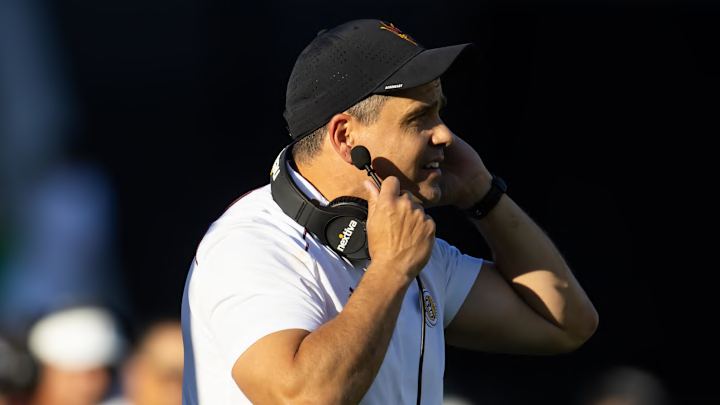When the Sun Devils drove down to Tucson to take on the 4-7 Wildcats, they knew they weren't exactly preparing for a dogfight. These two teams have been an inverse of each other all season long. Arizona was picked to finish fifth in the Big 12 in the preseason media poll, while Arizona State was picked to finish last.
Here we are, at the conclusion of the regular season, and the Sun Devils sit atop the conference and are about to go to Dallas to compete for the conference championship. Meanwhile, the Wildcats are second from the bottom, thanks only to Oklahoma State going 0-9 in conference play.
It was a demoralizing start for new head coach Brent Brennan, who made the controversial decision to bring in Dino Babers - a longtime head coach in his sixties who hadn't called plays in well over a decade - as his offensive coordinator rather than bring Kevin McGiven over from his same role under Brennan at San Jose State.
Babers inherited an offense littered with talent. Quarterback Noah Fifita and receiver Tetairoa McMillan were the marquee names, but they had other splashy skill players like receivers Montana Lemonious-Craig, Devin Hyatt, and Jeremiah Patterson alongside running backs Jacory Croskey-Merritt, Quali Conley, and Kendrick Reescano. On top of that, offensive tackle Jonah Savaiinaea is expected to be a first round draft pick this April.
Things never came together for Babers. For starters, Croskey-Merritt never suited up for the Wildcats over eligibility issues. Lemonious-Craig's role in the offense dwindled as the season went on, too, and he failed to record a reception in the final five games. Fifita became turnover prone and struggled mightily when throwing to anyone other than McMillan, his high school teammate.
The struggles out the gate led Brennan to strip Babers of his play calling duties, handing them over to tight ends coach Matt Adkins, who had worked exclusively at San Jose State under Brennan. The offense actually got worse with Adkins calling plays, as the problems only persisted and, if anything, became more exacerbated.
To put it lightly, Arizona State defensive coordinator Brian Ward wasn't quite facing a Herculean task in trying to shut down this offense last week. That said, he did become just the third defensive coordinator this year to hold Arizona to just seven points. Ward's game plan against the Wildcats was more impressive than the other two teams, Kansas State and Colorado, too.
The objective for defenses this year has been the same when facing Arizona: take away McMillan. That's easier said than done, of course. Kansas State held Arizona to just seven points, but McMillan still managed to put up 138 yards on 11 catches. Colorado held him to just 38 yards but McMillan caught all five of his targets. Their success was in sending so many double teams at McMillan that the Wildcats just stopped throwing his way.
Against Arizona State, and with nothing but pride left to play for, the Wildcats weren't going to let that happen again. Fifita targeted McMillan 12 times in the game, but he managed just six receptions. His 50% catch rate was the lowest he's seen all year. Those six catches translated to 68 yards and one score. The touchdown was a 28-yard bomb where McMillan simply beat the coverage. Outside of that big play, McMillan was averaging just eight yards per reception.
Ward came in with a plan to limit McMillan's effectiveness. His two biggest strengths are high-pointing the ball - nobody has more contested catches in the nation - and creating yards after the catch (YAC), where he ranks 11th among Power 4 receivers.
Ward's defense did not allow either of those to happen. He doubled down on his zone-heavy coverage scheme, running one of his highest zone rates of the year at roughly 75% of pass plays. That helped to create two-on-one matchups against McMillan on top of not allowing the physically gifted receiver to simply outrun or box out the Sun Devils' smaller cornerbacks.
Ward also dialed up his toolbox of simulated pressure looks, frequently mugging two linebackers in the A gaps to confuse Fifita pre-snap. All in all, Ward only blitzed Fifita on four dropbacks all day, but the Sun Devils generated pressure on nearly 31% of dropbacks. Fifita, who finished the game with a meager 48.3% completion rate, was the most erratic he's been all year, connecting on just 28.6% of his passes when Arizona State pressured him.
Between blanketing McMillan with zones and forcing Fifita to get rid of the ball fast, the defense was able to keep the star receiver from wrecking the game. He only caught one of his three contested targets, had two drops, and generated just nine yards after the catch. It was only the third time all year he's had single digit YAC in a game.
Ward's ability to successfully limit McMillan's impact is only underscored by the fact that Arizona only scored when throwing his way, and it was simply the result of a busted coverage assignment. The defense understood the assignment and they executed Ward's game plan perfectly. With McMillan neutralized for all but one drive, the Wildcats were unable to do much of anything else the rest of the game.
It was an encouraging performance for this defense, as they were able to limit a playmaker that few defenses have been able to shut down this year. The effectiveness of Ward's game plan, and the tenacity with which his defenders play, was a big reason for the gaping score differential by the time the clock hit triple zeroes.
